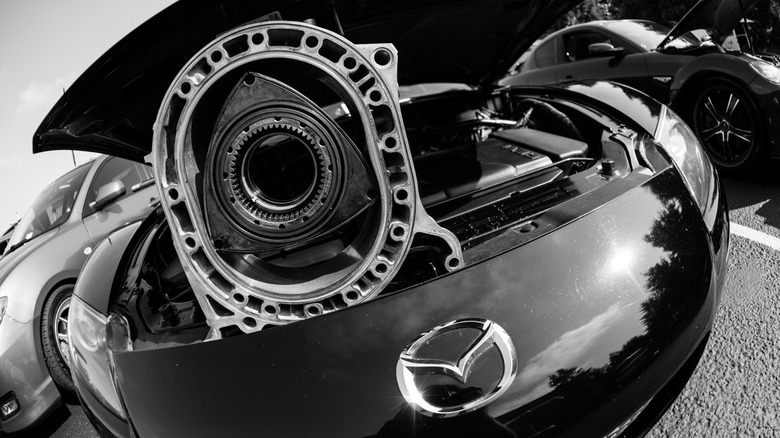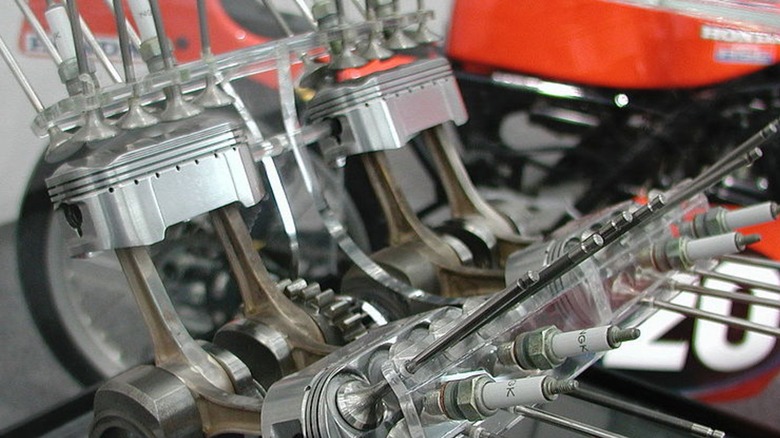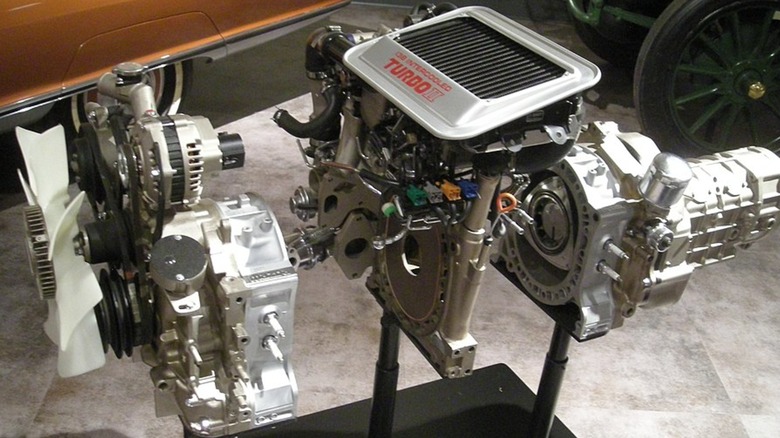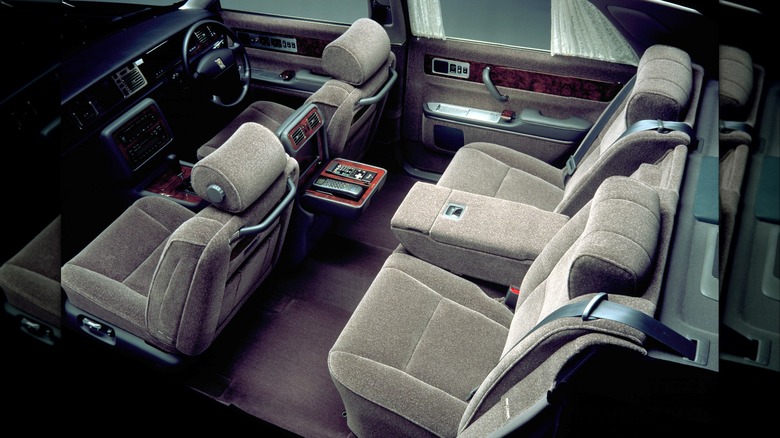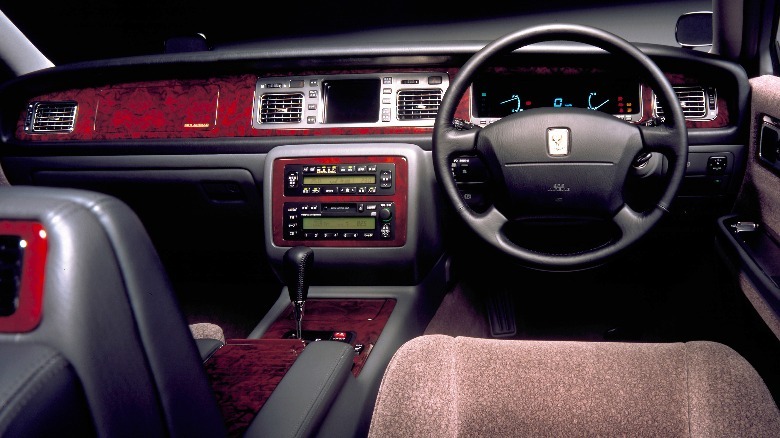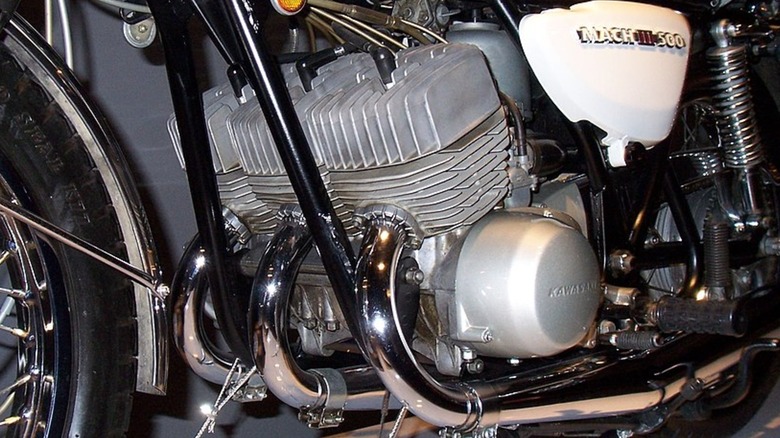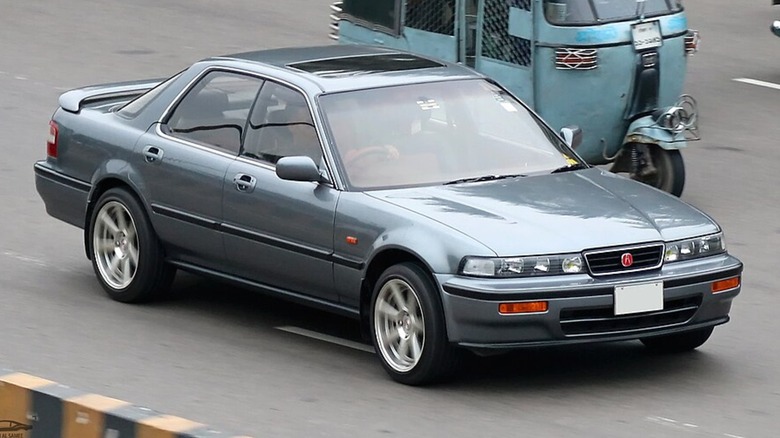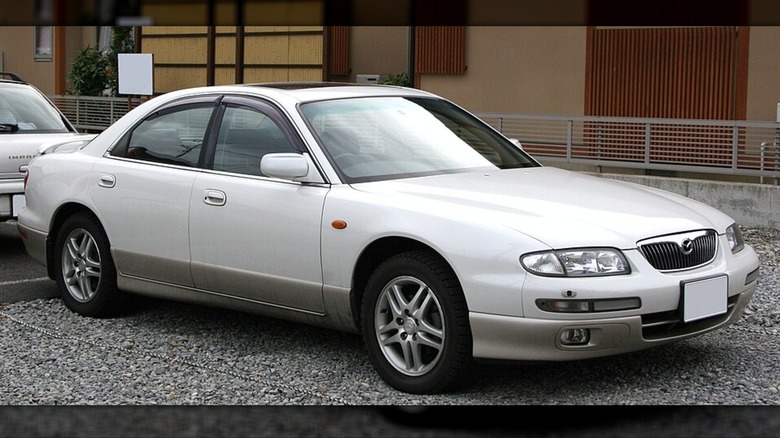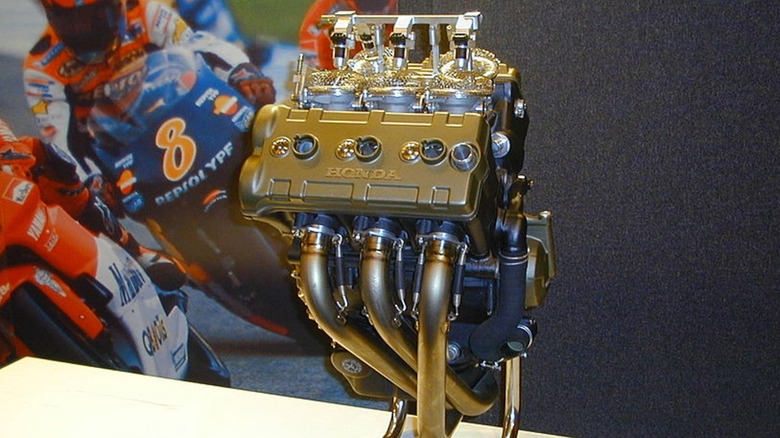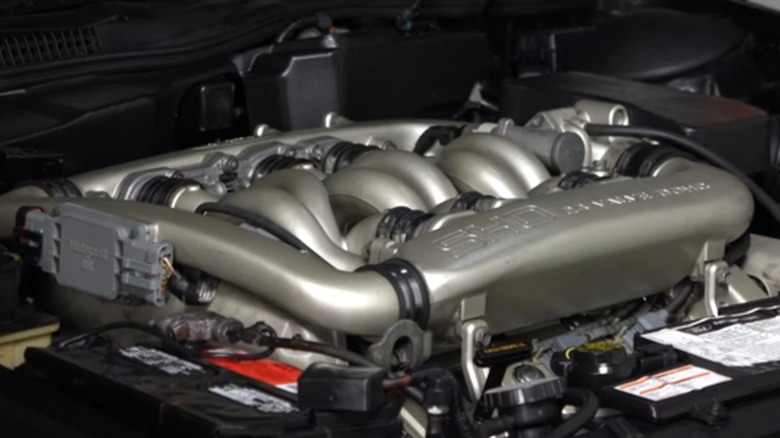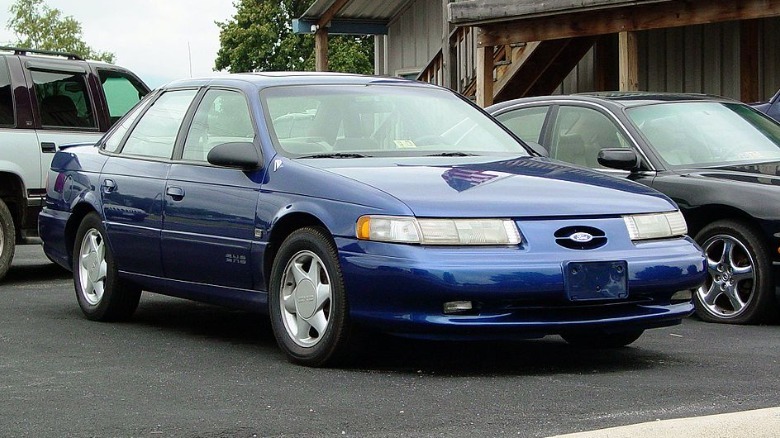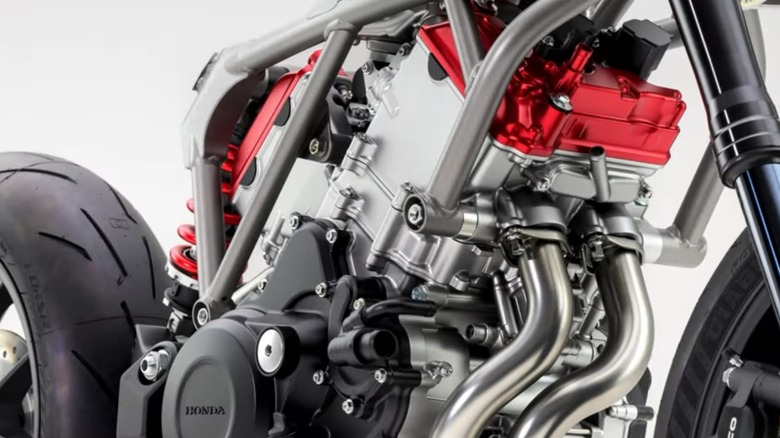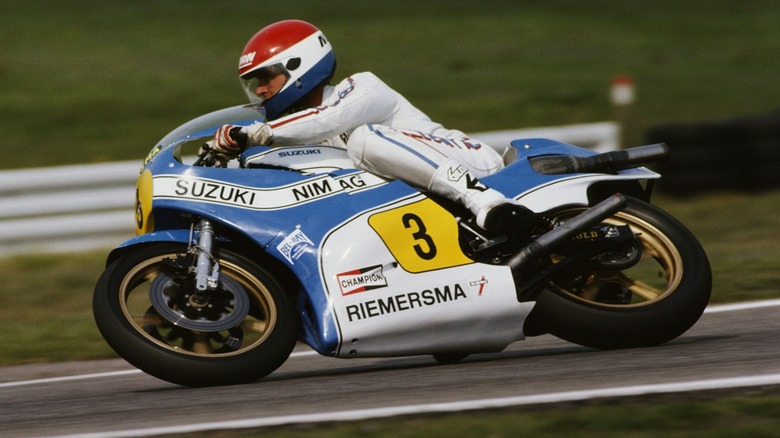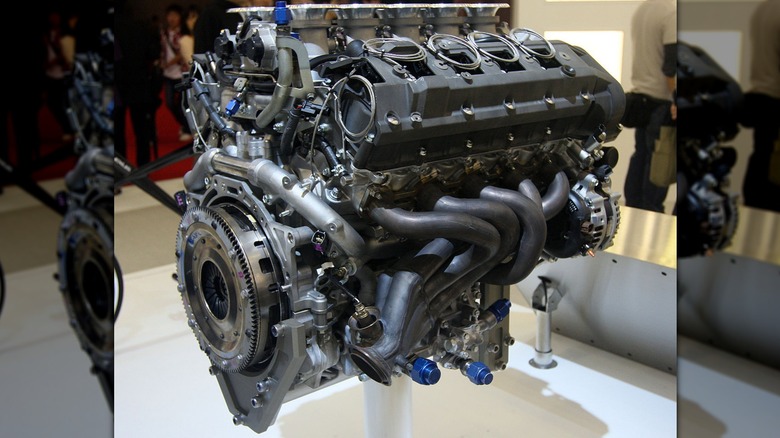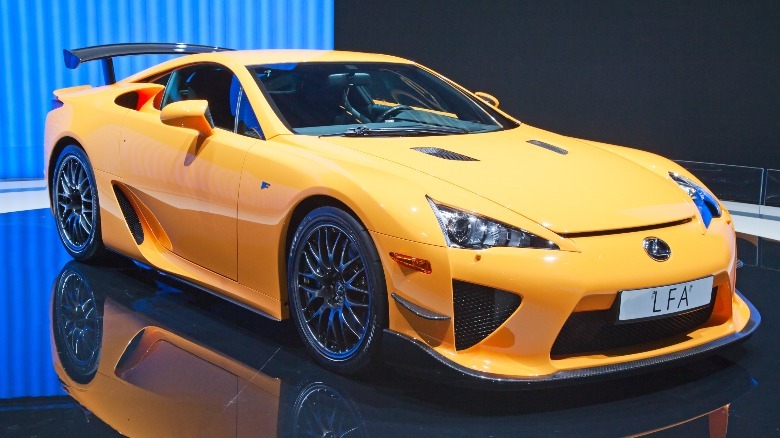12 Of The Most Unusual Japanese Engines Ever Made
Japanese automakers are renowned for their durable, reliable cars, and select engines are often described as bulletproof or unkillable. In many cases, straightforward engineering choices end up delivering quality machines, while common-sense manufacturing techniques prevail for others. After all, in the 1980s, Toyota built a California factory together with GM and taught it how to build a quality vehicle by implementing Toyota manufacturing practices. But among the numerous bog-standard Japanese four-cylinder and V6 engines, there are a few that stand out.
Within a multinational manufacturing corporation delivering automobiles to all parts of the globe, there are going to be some product developments that stray from the norm. Good engineering requires a degree of cleverness and creativity. For every time an automaker delivers a robust and predictable engine for a mainstream sedan, there are going to be a few experiments that never make it to development. However, occasionally, experiments make it well past the testing phase and into a production vehicle or onto the racing circuit. Many clever and unusual products can be attributed to Japanese ingenuity, and here are 12 engines to include among them.
Honda NR V4
Many Japanese motorcycles produced in the years after World War II used two-stroke engines. Although two-stroke engines are simple and cheap to make, and they can provide excellent power with good reliability, Soichiro Honda, founder of the eponymous manufacturer, hated them and worked to create competitive four-stroke machines instead.
Between 1979 and 1981, Honda fielded its NR500 Grand Prix race bike powered by a V4 engine with eight valves-per-cylinder facilitated by using oval pistons. However, it failed to achieve any big wins, forcing Honda to switch to two-stroke machines in 1982. Still wanting to build a competitive four-stroke bike, Honda revisited the oval piston idea and created the NR750, a V4 motorcycle with a total of 32 valves, eight spark plugs, twin throttle bodies, and an "8-into-4-into-2-into-1-into-2 exhaust system," according to Cycle World. With a short stroke, the V4 built power immediately, continuing seamlessly to its impressive 15,000-rpm redline.
Oval pistons are the anomaly of engine anomalies. This setup made it possible to create an engine with the components of a V8 in a rule-abiding V4 configuration. It never made for a race-winning bike, but it did demonstrate Honda's engineering superiority. Furthermore, Honda only built 300 copies of the NR750 and sold them for $50,000 in 1992, the most expensive Honda motorcycle to that date.
Mazda RX-7 Wankel
Although the clever rotary engine was invented by an enthusiastic supporter of the Nazi party, Felix Wankel, that didn't stop Mazda from acquiring the rights to use the design. Mazda developed it further than any other company has to date. The iconic rotary engine found its way into a series of Mazda cars, including the RX-2 through RX-5, the Japanese-market-only Cosmo, and the American-market-only REPU pickup, but it was the RX-7 that stuck and proved the triangle-powered engine's staying power.
Unlike conventional engines, the Wankel engine uses a triangle-shaped rotor with few moving parts to complete the Otto cycle via intake and exhaust ports, moving the combustion chamber in an oblong path. This motion turns the eccentric shaft in the center of the rotor, transferring motion back to the transmission. There are no valves, camshafts, lifters, rockers, timing chains, or dozens of other parts that cost efficiency and present opportunities for engine failure. It is an unusual engine indeed.
Since a Wankel engine has fewer parts, it is easier to manufacture and lighter than conventional engines. But if you are wondering why Mazda is the only company that has ever used it extensively, it has flaws. Even when a Wankel produces a lot of horsepower, its torque output is abysmal. Furthermore, the surfaces on the sides and tips of the rotors are difficult to seal, and its fuel efficiency is terrible, which is why most companies abandoned the technology in the '70s.
Toyota 1GZ-FE
When Toyota wanted to go upscale, it introduced Lexus to the American market in 1989. And even though the Lexus LS400 proved Toyota knew how to do luxury, many in Japanese society had already recognized this fact. Back in 1968, Toyota began selling a car made for the most discerning of the traditional Japanese business class with the kind of refinement expected by royalty. Furthermore, it became the only production car from Japan powered by a V12.
Despite being in production since 1968, the Century has only seen two complete overhauls. The first generation, powered by a sophisticated V8, lasted 30 years before being replaced in 1997 with a new generation featuring an all-new V12 engine up front. The latest generation arrived in 2017. Featuring 48 valves, four camshafts, a counterweighted crankshaft, and five liters of displacement, the 1GZ-FE V12 was not developed for making high horsepower while spinning up to maximum redline like an Italian bull. This engine received 12 cylinders for the sake of smoothness and refinement, providing plentiful momentum in obscurity.
The luxury propulsion provided by this V12 matches the opulence of the rest of the car. Each one is hand-built by Toyota's best craftsmen, with such detail that even the body-forming tools are custom-fitted to each worker's hands. When complete, it is perfection in motion, draped in reserved opulence, powered by the most unusual engine from Japan, a V12.
Mazda K8-DE
Although never one of Japan's largest automakers, Mazda has a long history of creating innovative cars with engaging driving experiences and stylish designs. Given its dedication to the Wankel rotary engine, the automaker is not afraid to take risks and introduce unorthodox designs. In the early '90s, Mazda produced one of the smallest V6 engines ever sold.
In 1991, Mazda introduced the fun and sporty MX-3 as a small but lively car suitable for younger buyers without requiring the extra space needed for a family. It was an affordable sporty coupe with good styling at a time when there was demand for such cars – few cars like this exist today. As a front-wheel-drive car, you might assume it to have an engine similar to other cars of the day — a four-cylinder in the range of 1.5 to 2.0 liters. Instead, Mazda split the difference and added two cylinders.
The 1.8-liter K8-DE V6 is an unbelievably small V6 with a respectable output of 130 hp, although equivalent four-cylinders offered more. Mazda created this engine primarily for the MX-3 but also used it in the Japanese-market Eunos 500 and select other models. This was part of its failed experiment with creating separate brands targeting different market segments. Japan's car taxes increase with engine displacement, so keeping it under 2.0 liters provided savings for domestic buyers at the time.
In the end, no other car received this unusually small V6, and it's unlikely any ever will.
Kawasaki Triple
During the 1960s, drastic changes took place in the motorcycle industry as British marques like BSA and Triumph began losing their dominance to Japanese bikes. It seems that almost overnight, riders abandoned their British twins as Japanese bikes grew in size and displacement. Kawasaki initially built a BSA copy but saw limited sales with it. Going back to the drawing board, engineers saw that they had a great 350cc twin already on the market and decided to add a cylinder.
Kawasaki launched a new model in 1969 called the Mach III, aka H1. It featured a new 500cc two-stroke triple that left anyone following in a cloud of blue smoke with their ears ringing from the cacophony of angry bees emanating from the tailpipes. For a hair under $1,000, buyers received a simple but slick lightweight bike packed with power that could clear a ¼-mile in 12.96 seconds and hit 125 mph. Oil injection, CDI ignition, and a lack of valve adjustments made ownership hassle-free, leaving time to terrorize the streets with impromptu street races.
The H1's success led Kawasaki to up the ante with a new 750cc Mach IV H2 triple in 1972. With 74 horsepower, this light-as-a-feather street bike was a lot to handle. The Kawasaki triples gained a reputation, earning them the nickname "Widowmaker." While those stories may have been overblown, the reign of the two-stroke triple ended as four-stroke four-cylinders took over the market.
Honda Inline-5
Among engine design choices, the five-cylinder is a rarity. Four, six, and eight-cylinder engines dominate the industry and have done so for well over a century. The first five-cylinder engine came in 1974 with the Mercedes-Benz 3.0-liter diesel for its 300D sedan. Audi followed with its own gasoline version a few years later, and Volvo eventually joined the trend.
Five-cylinder engines are only possible with fuel injection. They were never created for use with carburetors due to uneven fuel delivery and the challenge of designing an intake manifold for the odd number of cylinders. Even if these issues were resolved, the firing order, due to several engineering and physics-related reasons, made it impractical. But with fuel injectors at each cylinder, these problems are eliminated.
This engine design is an odd duck from the start, but millions of cars prove it can work. What you may not know is that a Japanese automaker joined the fray in the 1990s. Honda made a 2.5-liter five-cylinder for the Vigor, sold as the Acura Vigor in the States. The longitudinally-mounted inline-five, with the transmission positioned behind it, still drove the front wheels. It also made its way into the Acura TL but disappeared in 1998, remaining the only inline-five to power a Japanese car model to date.
Mazda KJ-ZEM
Mazda bet that its often unconventional approach to building cars could pay off in the luxury market of the 1990s, as its peers had successfully launched Acura, Lexus, and Infiniti. Playing catch-up, Mazda planned to launch a new luxury brand called Amati. Its timing could not have been worse, as Japan's economy went into a tailspin, forcing Mazda to scrap its luxury project entirely.
Mazda salvaged its failed project by releasing one of its Amati models as the Millenia, offering the top trim with an engine featuring an unusual operating cycle. In the Millenia S model, buyers could opt for a supercharged 2.3-liter V6. The supercharger was necessary as the V6 operated on the Miller Cycle instead of the Otto Cycle of almost all other engines. Essentially, this cycle keeps the intake valve open longer and increases efficiency through complex physics that are difficult to explain briefly. More importantly, this necessitates the inclusion of a supercharger to prevent the compressed fuel/air mixture from escaping through the intake manifold. Therefore, the supercharger is not a high-performance accessory, but a high-efficiency requirement.
The Millenia turned out to be a competent but unexciting car, fitted with upscale trim competitive with a Lexus or Acura. Regardless, sales did not pan out, and Mazda's experiment with luxury stalled. The clever and unusual Miller Cycle V6 also disappeared when Millenia production ended, as it failed to bring significant benefits to justify its complexity and added manufacturing expense.
Honda RC211V
Although the five-cylinder engine featured in select Honda automobiles remains relatively obscure, its motorcycle division once made one with a more significant impact. Honda created a sensation with its 1958 Super Cub, which went on to be a worldwide success. And as its diminutive commuter bike sales skyrocketed, Honda set its sights on the track, entering the 1959 Isle of Man TT and gaining its first all-out win at the 1961 Spanish Grand Prix.
Development of first-class racing bikes tuned to win continues to be an integral part of Honda's DNA. While Honda had reluctantly used 500cc two-stroke machines as the rules permitted, a MotoGP rule change allowing four-stroke bikes up to 990cc spurred it to develop a new power plant. The new MotoGP bike then had an engine with a highly unusual setup: a V5.
With three cylinders up front and two in the rear, one might think this engine would be inherently unbalanced. The opposite is true, as engineers changed the 90-degree V-angle of a V4 engine to a 75.5-degree V-angle and used the additional piston to resolve balancing issues. This resulted in an engine more compact than a V4 with the same displacement while eliminating the weight of a balance shaft. The V5 produced up to 260 horsepower, pushing the Honda team to multiple victories and establishing four-stroke dominance.
Yamaha 3.0-liter V6
While Yamaha Motor Company often receives praise for its excellent dirt bikes, quads, and watercraft, most people likely know little of its work with automobiles. However, the motorcycle manufacturer occasionally lends its expertise to automakers, such as when Toyota hired Yamaha to help develop the 1965 Toyota 2000GT, one of the best Toyotas ever designed.
Saddled with a lineup of unstylish and aging cars in the early '80s, Ford set out to turn things around with a new sedan. Taking cues from Europe and Japan, it launched the Taurus in 1985 — a car that turned things around for Ford and became a sensation.
To create what would become the Taurus SHO, Ford collaborated with Yamaha to design an entirely new 3.0-liter DOHC V6 engine, engineered specifically for high-performance applications. Yamaha created new aluminum cylinder heads, each carrying a pair of camshafts to control a total of 24 valves, raising its redline to 7300 rpm and adding 80 horsepower. What made this engine truly unusual was that Yamaha not only designed but also manufactured it for Ford, transforming the Taurus into an iconic 220-horsepower sleeper.
Honda Supercharged V3
Although it has not yet been released, Honda's newest engine is making waves for several unusual engineering choices. While details are still scant following its unveiling at EICMA 2024, it does present us with what looks like highly clever and unique engine packaging.
Triples may not be the most common engine layout for motorcycles, but they are far from unusual. However, the triples we are most accustomed to align the cylinders in a row, either longitudinally or transversely mounted. This new Honda block sports a V3 arrangement with two forward cylinders and a middle cylinder canted toward the rear. This arrangement is not completely novel as Honda once raced a two-stroke 500cc V3 with two cylinders up and one down, all forward facing. Yet, this new engine will be worlds apart in many ways, most significantly because it looks poised to go into production.
Honda releasing a new V3 is not necessarily groundbreaking, but adding a supercharger — more specifically, an electric supercharger — certainly is. Currently, only electrically assisted turbochargers are found in production vehicles, as the power required for a fully electric one makes the concept infeasible. While Honda has not yet released technical specifications about this new engine, it seems to be leveraging the relatively small displacement with battery power alone for forced induction. It looks promising, but time will tell whether or not it works in the real world.
Suzuki RG500
Like its counterparts, Suzuki's success is rooted in reliable machines built with proven technology and traditional layouts. When an inline-4 engine is powerful, reliable, and efficient engine, sticking with it makes sense. Yet, in racing, experimenting with unorthodox designs can pay off.
Back in the '70s, Suzuki sought to enter Grand Prix racing in the 500cc class, where MV Agusta's powerful four-stroke triple dominated. At the time, Suzuki only made small two-stroke bikes back then, making it a highly unlikely competitor. Determined to make its mark, the Suzuki development team for the project, consisting of two people for the engine and two for the chassis, got to work on a new two-stroke, mostly since it was what they knew. It was a choice that had them branded as crazy.
The team used an engine layout previously used for smaller engines, upsizing it to fit the Grand Prix 500cc class. This was a square-four configuration, with a pair of cylinders up front and another in the rear — joined by gearing on their individual crankshafts. It is a bulky design, but without camshafts and valves, it wouldn't suffer from being overweight. The unusual engine design resulted in multiple championship titles and established two-stroke engines as viable in competition. Success on the track translated into sales success, and the RG500 street bike copied most of what customers saw on the track, making it a valuable machine today.
Lexus 1LR-GUE
For many years since its introduction, Lexus followed its mantra, "The relentless pursuit of perfection." For more than a decade, this meant building the finest luxury cars possible, and Toyota largely achieved its goals. Lexus quickly became recognized for its focus on offering luxury with Toyota's legendary reliability. While Toyota did well offering supremely comfortable cars, few might say they were exciting. That was meant to change in 2010 with the release of the LFA.
The culmination of a decade of development, the Lexus LFA stunned everyone upon introduction. It represented Toyota's uncompromising commitment to creating the finest high-performance luxury car — no expenses spared. Early in its development, chief engineer Tanahashi Haruhiko turned to Yamaha for help in creating the perfect engine. Yamaha agreed but emphasized that Toyota's careful and conservative approach to building cars needed to be set aside to push the envelope. Fortunately, he listened, and Yamaha built a masterpiece.
Aside from racing or heavy-duty diesel engines, the Lexus LFA's V10 is one of the few production V10 engines developed by a Japanese company. The naturally aspirated V10 produced peak horsepower at an incredible 8,700 rpm, just short of its 9,000 rpm redline. Yamaha Motor and Yamaha Corporation collaborated to design the acoustic properties of the Lexus LFA's engine, creating a sound that enhances the driving experience. No other engine by Toyota has since matched the perfection of the Lexus LFA V10, and few engines by others even come close.
